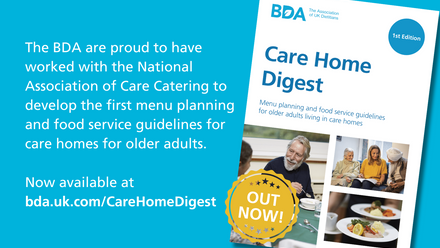Naomi Asembi reports on a survey of Oxfordshire care homes to evaluate how they manage malnutrition.
Oxfordshire Clinical Commissioning Group brought in a policy nearly ten years ago to restrict prescribing of oral nutritional supplements (ONS) for care home residents. By adding a ‘block’ status on the formulary, and by implementing a policy with specific exclusion criteria, it meant that care homes had to rely less on ONS and instead had to primarily use food-based interventions to manage malnutrition, where possible. Food-based interventions include fortifying foods and drinks, offering high-energy snacks and nourishing drinks, optimising the eating environment and providing feeding assistance as needed.
The premise of the policy was never to block supplements entirely. ONS should be prescribed to individuals who need them. Within this policy there is an agreed list of scenarios where ONS may be prescribed:
a) residents requiring bolus feeds via an enteral feeding tube
b) residents with acute inflammatory bowel disease (IBD) where a liquid/elemental diet is required
c) residents with stage 5 chronic kidney disease (CKD) or those who are unable to meet their nutritional requirements because of renal dietary restrictions
d) residents with a diagnosis of head and neck cancer or motor neurone disease
Many historic clinical commissioning groups (CCGs) and other integrated care boards (ICBs) do not restrict ONS in care homes with a policy. Some areas have guidelines or restrictions on ONS usage in care homes, such as only after assessment by a dietitian or via monthly request forms.
There have been many audits and service evaluations in care homes to assess how they manage malnutrition. This project, however, offered a different opportunity to evaluate if care homes need ONS as part of the care plan for prevention and management of malnutrition, or if they can meet residents’ nutrition needs through focused food-based methods, by evaluating the quality of their malnutrition management care and assessing prevalence of malnutrition.
In July 2022, Buckinghamshire, Oxfordshire and Berkshire West Integrated Care Board (BOB ICB) was created from their respective CCGs. The aim of the ICB is to align its policies across the whole patch, and this project served to evaluate whether the policy should be extended from Oxfordshire to other areas and what support would be needed to do so.
Management of malnutrition
National estimates of malnutrition prevalence are ‘over 1 in 3’, based on BAPEN surveys of care home residents. The latest survey only looks at 86 residents and found 55% were at risk of malnutrition.2 Previous years’ larger surveys show 37% of care home residents had malnutrition.3
The Health and Social Care Act 2008 (England) Regulation 14 states that, where relevant, “providers must make sure that people have enough to eat and drink to meet their nutrition and hydration needs and receive the support they need to do so. People must have their nutritional needs assessed and food must be provided to meet those needs. This includes where people are prescribed nutritional supplements and/or parenteral nutrition”.4 Though there is Regulation 14 and guidance on good nutrition and hydration care from NICE,5 6 the BDA,7 the CQC and NHS England,8, 9 there is no national guidance from the government on a set standard for nutritional care in care homes in England.
ONS are a tool to improve nutrition and hydration status. Studies have shown their clinical benefits on improved weight,10 reduced pressure ulcers,11 hospitalisation, mortality, infections, falls and postoperative complications12, and cost-effectiveness compared with dietary advice.13 Other studies do not show an impact on prevalence or consequences of malnutrition,14 15 16 and report that it is rather the increased nutrient intake that conveys the clinical benefit – which can be achieved through dietary means.17
With the recently published Care Home Digest from the BDA,7 there is momentum for care homes to reduce their reliance on ONS and apply food-based strategies, such as food fortification and homemade milkshakes to meet residents’ nutritional needs.
BOB ICB invited a sample of 10% of the 134 care homes across Oxfordshire to participate in a survey to evaluate how they manage malnutrition. Fifteen homes of different bed sizes, specialties and localities participated. The care home manager, or lead, and catering lead were interviewed during visits to the homes.
The survey covered an audit of at least 10% of residents’ Malnutrition Universal Screening Tool (MUST) scores, collation of MUST scores for all residents, key health conditions for those identified at high risk of malnutrition, frequency of drinks rounds, types of drinks, cooked meals and snacks available, food fortification methods, their homemade milkshake recipe (in order to calculate cost, calories and protein), ratio of staff available to assist at mealtimes, food chart usage, documentation and communication of dietary requirements, presence of a nutrition champion, use of local resources, and training received.
There were 650 residents with MUST scores in the 15 homes in this survey. Malnutrition prevalence was on average 38%: 24% high risk of malnutrition (10–47%), 13% medium risk (7–24%). This is comparable with national estimates where ONS usage is not restricted by a policy.
Most (54%) of those at high risk of malnutrition had a background of advanced progressive conditions or were palliative. Others had had recent infections, increased activity – eg, because of wandering – or were long-term slim but eating well.
It was found that 35% (0–83%) of the 94 audited MUST records had calculation errors. One care system had a programming error that was identified through this audit and resolved with the software team. Note that there were no errors in the two homes where all staff were MUST trained. This shows that training for all staff is necessary for accurate MUST. scoring and for promptly identifying and addressing the signs and symptoms of malnutrition.
Nutrition and hydration provision
Meal service provision varied: all homes offered cooked breakfasts and fortified porridge, and a third of homes offered a three-course meal at lunchtime and soup and sandwiches (or a light meal) in the evening, with a cold pudding. Two-thirds of homes also offered a proper cooked meal in the evening.
More than half of care homes practised bespoke fortification at kitchen level – eg, by the plate for named individuals or separate trays on the hot trolley of standard and fortified options for those who need it. Some homes had only one chef or served meals ‘restaurant-style’, which makes bespoke fortification more challenging, as they are not pre-ordered and prefortified. Fortifying meals on the unit was not a common practice and was not linked to lower prevalence of malnutrition, which may be because of inconsistent application. There has also been feedback that care staff add too much of a fortifying ingredient or add an unappetising match, so the food is wasted – for example, cold cream poured over roast dinners. Approximately half of homes were fortifying hot drinks with fortified milk on the units.
On average, care home homemade milkshakes had similar energy to the most prescribed bottled ONS at 300kcals, (138–593kcals), but only three out of 14 milkshake recipes had equivalent protein to the most prescribed bottled ONS (12g per serving). On average, ingredients cost 39p (25–67p) per 200ml serving vs £1.48 for the most prescribed standard-volume ONS.
Food diary use was varied from three days to always, and mainly used to confirm poor oral intake to justify investigation into underlying causes. Homes displayed a confidence in addressing the medical underlying causes of weight loss and in knowing when to transition to a comfort for quality-of-life approach when nutritional intervention would be limited, such as during end-of-life care.
Prevalence of malnutrition was higher when:
- fewer staff were available to assist at mealtimes
- there was only general minimal fortification and meals were prepared the same way for all residents
- there was no nutrition champion (30% average MUST 2+ in the nine homes without a nutrition champion vs 19% MUST 2+ if homes had a champion)
- not using local dietetic resources (28% average MUST 2+ in the 11 homes not using resources, vs 17% in the four homes that did)
Performance results were RAG-rated (top 25% green, bottom 25% red and average performance yellow). No home had a perfect score, indicating that all homes require education to improve and standardise their nutrition and hydration care.
Usage of ONS
Most homes in the samples had no residents prescribed ONS. Four homes had one or two residents prescribed ONS, and two homes had five or six residents prescribed ONS.
Each home reported cases for which it was difficult to meet nutritional needs. The themes of these were:
- residents with IDDSI level recommendations who, because of their condition, are sleeping during the day. Because of food hygiene, food from the day is not allowed to be reheated, and night staff are not IDDSI trained
- paranoia around foods and drinks, and fear of poisoning. Residents respond better to packaged food or drink items that are opened in front of them, making it challenging to offer fortified foods or homemade milkshakes
- pressure wounds with increased protein requirements, but disliking or not tolerating dairy
For the policy restricting ONS to extend to other areas, it must be made clear that ONS should be made available to those who clinically need them. It is also important for MDTs working to manage contributing factors, such as IDDSI training for night staff, providing resources on non-dairy fortification or involving mental health services.
Alongside the survey, a database search of GP records identified the number of care home residents prescribed ONS in the past six months (excluding tube-fed). This relied on correct coding of tube feeding and of care home residency. This showed 5% of Oxfordshire care home residents were prescribed ONS, versus 10% across the ICB, where there is not currently a policy restricting ONS prescribing in care homes.
The top five prescribing GP practices were audited to identify the rationale behind ONS prescribing and appropriateness based on malnutrition risk. There were 61 patients identified. No prescribing met the criteria of Policy 277; instead, most had a background of dementia or palliative care. Further, more than 40% had a MUST score below 2. MUST scores were infrequently documented in patient records and the rationale for commencing ONS was general weight loss or poor eating. The average cost of a prescription was £82 (£14–£244) per month per resident. This may cost approximately £65,000 per month for 791 residents in BOB (£11,000–£193,000).
More than 85% of the costs of ONS could have been avoided or reduced by switching from bottled ONS to powdered ONS, by avoiding prescribing when the MUST score was below 2, and by discontinuing ONS after discharge from hospital. With more clarity on when to prescribe and what to prescribe, costs to the NHS could be saved.
Overall impression of malnutrition management and next steps
This survey has shown that restricting ONS use via a policy halves usage, but having a policy in place does not prevent all inappropriate prescribing. Greater awareness is needed among prescribers, and those who request prescriptions, for when to prescribe and when to promote food-based interventions.
The survey also showed that prevalence of malnutrition was comparable with national estimates (where ONS usage is not restricted) and this finding reinforces the position that care homes can meet nutrition and hydration needs through food and drink, without relying heavily on ONS. However, the variability in homemade milkshake composition and extent of fortification shows that training should be provided to standardise nutrition and hydration care. As there are highly complex individuals residing in care homes, beyond the remit of the policy exclusion criteria, ONS should be available for those who need them, on a case by-case basis, alongside regular monitoring to make sure ONS are having a therapeutic effect.
Our policy review and service evaluation may be useful for the wider dietetic services and commissioning bodies to assess the quality of nutrition and hydration care in their local care homes, and to consider training programmes, policies, ‘block’ formulary status, and promotion of food-based interventions to reduce reliance on ONS, while meeting residents’ nutrition and hydration needs.
References
- C A Russell and M Elia on behalf of BAPEN and collaborators. Nutrition Screening Surveys in Care Homes in the UK: A Report Based on the Amalgamated Data from the Four Nutrition Screening Week Surveys Undertaken by BAPEN in 2007, 2008, 2010 and 2011. 2015.
- Stratton R, Cawood A, Anderson L, et al. Malnutrition and Nutritional Care Survey in Adults UK Malnutrition Awareness Week, October 2022. 2022.
- Russell CA, Elia M. BAPEN – Nutrition Screening Survey and Audit in the UK and Republic of Ireland in 2011 – Hospitals, Care Homes and Mental Health Units. 2012.
- CQC Regulation 14: Meeting Nutritional and Hydration Needs – Care Quality Commission. n.d. Available from: www.cqc.org.uk/guidance-providers/regulations/regulation-14-meeting-nutritional-hydration-needs [Last accessed: 10/19/2023].
- NICE. CG32 Nutrition Support for Adults: Oral Nutrition Support, Enteral Tube Feeding and Parenteral Nutrition. Available from: www.nice.org.uk/guidance/cg32/chapter/Introduction [Last accessed: 10/19/2023].
- NICE QS 24 Nutrition Support in Adults Quality Standards. Available from: www.nice.org.uk/guidance/qs24 [Last accessed: 10/27/2023].
- BDA. Care Home Digest – British Dietetic Association (BDA). Available from: www.bda.uk.com/practice-and-education/nutrition-and-dietetic-practice/care-home-digest.html [Last accessed: 7/19/2024].
- NHS Commissioning – 10 Key Characteristics of ‘Good Nutrition and Hydration Care.’ Available from: www.england.nhs.uk/commissioning/nut-hyd/10-key-characteristics/ [Last accessed: 11/24/2023].
- NHS England – Providing Proactive Care for People Living in Care Homes – Enhanced Health in Care Homes Framework. n.d. Available from: www.england.nhs.uk/long-read/providing-proactive-care-for-people-living-in-care-homes-enhanced-health-in-care-homes-framework [Last accessed: 3/14/2024].
- Malafarina V, Serra Rexach JA, Masanés F, et al. Results of High-Protein, High-Calorie Oral Nutritional Supplementation in Malnourished Older People in Nursing Homes: An Observational, Multicenter, Prospective, Pragmatic Study (PROT-e-GER). J Am Med Dir Assoc 2021;22(9):1919-1926.e5; doi: 10.1016/j. jamda.2021.02.039.
- Heyman H, Van De Looverbosch DE, Meijer EP, et al. Benefits of an Oral Nutritional Supplement on Pressure Ulcer Healing in Longterm Care Residents. J Wound Care 2008;17(11); doi: 10.12968/jowc.2008.17.11.31475.
- Elia M, Normand C, Laviano A, et al. A Systematic Review of the Cost and Cost effectiveness of Using Standard Oral Nutritional Supplements in Community and Care Home Settings. Clinical Nutrition 2016;35(1):125–137; doi:10.1016/j.clnu.2015.07.012.
- Elia M, Parsons EL, Cawood AL, et al. Cost-effectiveness of Oral Nutritional Supplements in Older Malnourished Care Home Residents. Clinical Nutrition 2018;37(2):651–658; doi: 10.1016/j. clnu.2017.02.008.
- Thomson KH, Rice S, Arisa O, et al. Effectiveness and Costeffectiveness of Oral Nutritional Supplements in Frail Older People Who Are Malnourished or at Risk of Malnutrition: A Systematic Review and Meta-analysis. Lancet Healthy Longev 2022;3(10):e654–e666; doi: 10.1016/S2666-7568(22)00171-4.
- Mountford CG, Okonkwo ACO, Hart K, et al. Managing Malnutrition in Older Persons Residing in Care Homes: Nutritional and Clinical Outcomes Following a Screening and Intervention Program. J Nutr Gerontol Geriatr 2016;35(1):52–66; doi: 10.1080/21551197.2015.1131797.
- Streicher M, Themessl-Huber M, Schindler K, et al. nutritionDay in Nursing Homes – The Association of Nutritional Intake and Nutritional Interventions With 6-Month Mortality in Malnourished Residents. J Am Med Dir Assoc 2017;18(2):162–168; doi: 10.1016/j.jamda.2016.08.021.
- Baldwin C, de van der Schueren MAE, Kruizenga HM, et al. Dietary Advice With or Without Oral Nutritional Supplements for Disease-related Malnutrition in Adults. Cochrane Database Syst Rev 2021;2021(12); doi:10.1002/14651858.CD002008. PUB5.







